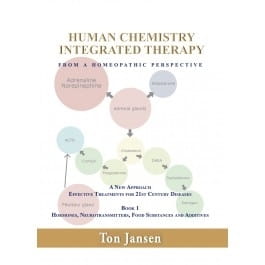Ton Jansen has worked tirelessly for 35 years to achieve quick, gentle and lasting cures for his patients. In this book, his third, he continues to add new remedies to reach this goal for our patients. It is an indispensable tool to achieve consistently better results in our practice.
Homeopathy must adapt to a world that is increasingly challenging our health. Ultimately, no-one can argue with clear, clinical results.
This is the first book in the series Human Chemistry.
Books on Body’s Own Substances, Vitamins, Organ remedies, Nosodes and more will be published soon. These will also include an explanation of how Ton applies blood testing, and the results in his practice.
This book can be seen as the sequel to Fighting Fire with Fire. The general principles explained in Fire are applicable here too.
INSIDE:
Materia Medica of over 55 remedies based on hormones, neurotransmitters and on food substances and additives. Of course Ton has included explanatory drawings and cases with many remedies to help you include this method in your practice.
- Author: Ton Jansen
- ISBN: 9789461013644
- 304 pages
- Hardback
- Published in 2021
- Printed in Netherlands
Reprinted with the permission of the Alliance of Registered Homeopaths, from the 'Homeopathy in Practice' Journal, Spring/Summer 2022 edition. Reviewed by Chelsea Green, MARH.
I was excited to be asked to review Human Chemistry, Integrated Therapy as I am a big fan of Ton Jansen's Fighting Fire with Fire. This new book follows on from Fighting Fire with Fire (reviewed in HiP Spring/Summer 2017) and a third book in this series is already in production. See also the review of Finding Your Way Through The Forest of Symptoms in HiP Winter 2021/2022. This book presents the materia medica of hormones, neurotransmitters, food substances and additives.
Ton defines 'Human Chemistry, Integrated Therapy' as using homeopathy and orthomolecular supplements along with dietary and lifestyle advice. He uses blood tests to reveal imbalances in a person's system and identifies the relevant sarcodes and nutritional substances to restore balance. He came to this methodology after facing many obstacles to cure following patients' exposure to pharmaceutical drugs.
Ton tells us that this book grew out of his practice of human chemistry, which he began in 1987. By 2002, when he was calling his method 'Homeopathic Detox Therapy', he realised the need to look more closely into human chemistry and started examining blood tests for information on the state of health of the patient. This birthed the new approach 'Human Chemistry, Integrated Therapy'. I would like more information on what blood tests he is using but maybe this will be covered more in later books.
For those who have not read Fighting Fire with Fire, chapter one of Human Chemistry, Integrated Therapy includes the homeopathic detox therapy methodology including the remedy course timetable, the opening remedy, weekly supporting remedy and combining detox courses. There are two changes from the original methodology; the first being that rather than ascending potency prescribing starting at 30c, Ton now sometimes uses 6c through to a 200c. The second change is that, in his hierarchy of toxins, vaccinations has moved up to second place behind hormone disruptors.
In Chapter 2, Ton explores what is meant by Human Chemistry, Integrated Therapy and explains the way our body interacts with the outside world. In order to work with this method, we need to understand the microbiome, hormones, neurotransmitters, digestion, the blood and lymphatic systems, bodily processes and how they work together, and the significance of vitamins and minerals. Through this knowledge, the therapy aims to rebalance the body at a cellular level.
The therapy uses orthomolecular treatment - the use of vitamins and minerals to optimise the nutritional environment in the body together with nutritional advice. As Hahnemann said, the absence of good nutrition may mean that the 'best selected homeopathic medicine does not affect an improvement. A strong timeline is required in the use of this method and Ton provides his timeline template.
Chapter 3 covers food advice and nutritional supplements. The advice here repeats information in Chapter 10 of Fighting Fire with Fire plus some additions. Much of the original advice, as well as new suggestions such as avoiding blue light, and not eating pork or farmed fish, are no surprise to us. Whilst agreeing with Hahnemann's recommendation to avoid such things as coffee, spicy food, and strong scents, Ton acknowledges that this would make homeopathy too restrictive and patients are often unwilling to address such suggestions. He takes a more practical approach, preferring to give nutritional advice that is more achievable for clients.
The chapter closes with a brief look at nutritional supplements with the focus on zinc and selenium for removal of toxins. This is followed by a short chapter on remedy reactions with suggestions of what to do if reactions occur.
The second half of the book has chapters on hormones, neurotransmitters and food substances and additives. Each chapter introduces the topic; for example neurotransmitters, how they function, what influences them, and symptoms when out of balance, followed by remedy pictures and case studies. The chapter on neurotransmitters, for example, includes materia medica for Acetylcholine, Dopamine, GABA neurotransmitter precursors like 5-HTP among many others.
As Ton's previous book, Human Chemistry, Integrated Therapy is easy to read and practical in that you can start applying it straight away. There are a lot of case studies highlighting the use of the methodology and the sarcodes. I recommend this book and am looking forward to reading the rest in the series.

